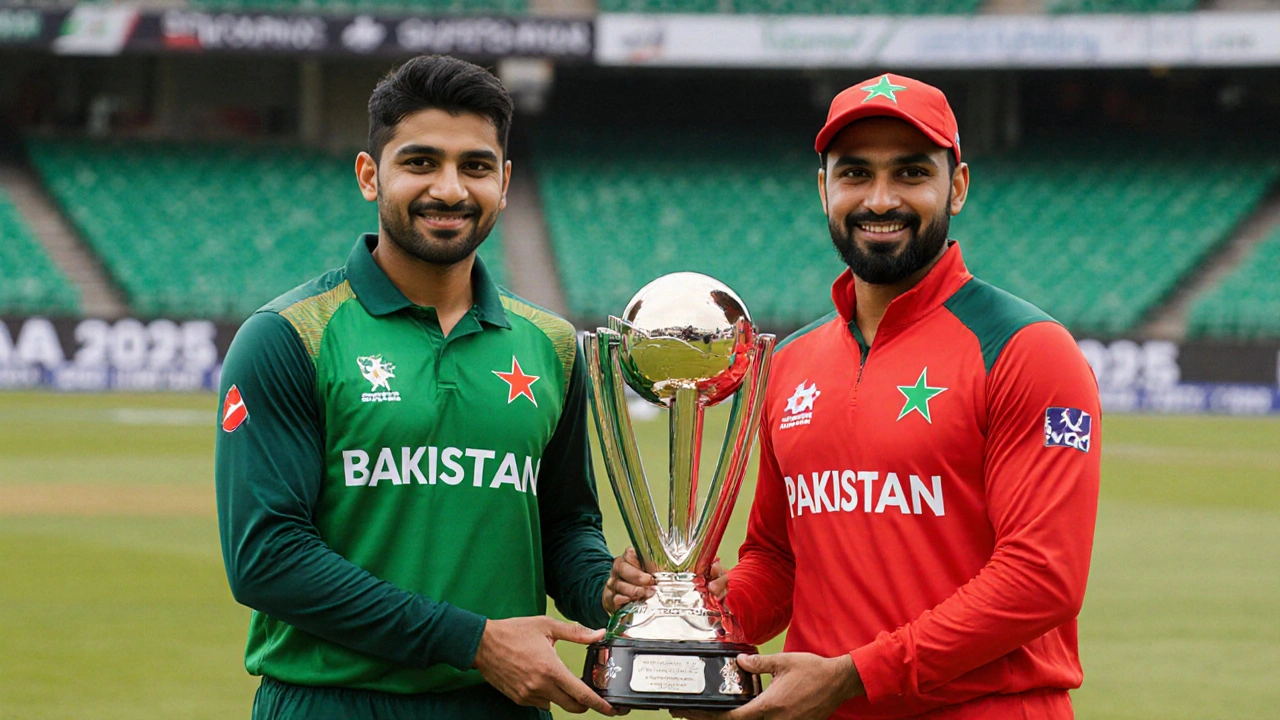Tomorrow night, the Dubai International Cricket Stadium will host one of the most critical fixtures of the Asia Cup 2025. Pakistan and Bangladesh lock horns in a winner‑takes‑all Super Four encounter that will decide who joins India in the tournament’s finale. With both sides having just one game left to stay alive, the atmosphere promises to be electric, and every decision on the field could become a defining moment.
Why the match matters for both teams
Pakistan entered the Super Four phase on a shaky note, losing their opening game to India. However, the Men in Green quickly recovered by handing Sri Lanka a convincing defeat, showcasing a blend of aggressive batting and disciplined bowling. That bounce‑back has restored confidence, especially in the fast‑bowling department led by Shaheen Afridi and Haris Rauf, whose pace and swing have troubled opposition batters throughout the tournament.
Bangladesh, meanwhile, endured a heavy loss to India that exposed gaps in both their batting depth and death‑over strategies. Coach and management used the defeat as a chance to bench a few first‑choice players, preserving them for this decisive match. The return of experienced campaigners such as Litton Das and all‑rounder Mahedi Hasan raises expectations that Bangladesh can match Pakistan’s firepower and push for their first Asia Cup final since 2018.
Pitch, weather and tactical angles
The Dubai International Cricket Stadium has produced a balanced surface in the Super Four series. The wicket typically offers good bounce and carry for quicks, while still rewarding batsmen who can time the ball well on the shorter boundaries. Evening fixtures have seen defending totals around 135‑140 runs, meaning a first‑innings score in that corridor could provide a psychological edge.
Weather forecasts for the evening of September 25 are promising: clear skies, temperatures hovering between 30‑32 °C, and low humidity. These conditions favor a fast‑bowling spell early on, as the ball tends to swing under the lights before the air cools slightly. No rain is expected, so both teams can plan for a full 20‑over innings without interruptions.
Strategically, Pakistan will likely open with Saif Hassan and Parvez Hossain Emon, who have been effective in exploiting the early bounce. The middle order, anchored by Mohammad Haris and seasoned campaigner Mohammad Nawaz, will aim to accelerate once the powerplay ends. The fast duo of Afridi and Rauf, supported by spin options Saim Ayub and Mohammad Nawaz, should look to apply pressure throughout the innings.
Bangladesh’s game plan will revolve around a tight opening partnership, perhaps featuring a steady left‑hander paired with a right‑hander to rotate the strike. The return of Litton Das at number three could stabilize the innings and provide an option to attack the slower bowlers. In the death overs, the team will count on Taskin Ahmed’s raw speed and Mustafizur Rahman’s deceptive slower ball to restrict Pakistan’s chase.
Both captains—Salman Agha for Pakistan and Jaker Ali for Bangladesh—are known for making bold field adjustments. Their on‑field decisions, especially concerning bowler rotations and powerplay field placements, will be pivotal. A well‑timed bowling change could swing the momentum dramatically, given the relatively low target range for a final.
Probable playing XIs and key players to watch
- Pakistan XI (probable): Salman Agha (c), Saif Hassan, Mohammad Haris, Mohammad Nawaz, Shaheen Afridi, Haris Rauf, Saim Ayub, Mahedi Hasan (as a batting all‑rounder), and a mix of emerging talent in the lower order.
- Bangladesh XI (probable): Saif Hassan (c), Parvez Hossain Emon, Litton Das, Mahedi Hasan, Mustafizur Rahman, Taskin Ahmed, plus spin options like Shakib Al Hasan (if fit) or a young leg‑spinner, and a flexible finisher for the final overs.
Key battles to watch include Shaheen Afridi’s ability to extract bounce against Bangladesh’s top order and Mustafizur Rahman’s skill in mixing pace and flight to outfox Pakistan’s middle order. On the batting side, Litton Das’s composure under pressure could set the platform, while Mohammad Haris’s aggressive intent may tilt the chase in Pakistan’s favour.
Historical context and what the numbers say
In T20 encounters, Pakistan enjoys a superior head‑to‑head record over Bangladesh, winning a majority of the past ten clashes. However, Bangladesh’s recent rise in world rankings and improving performances against top teams suggest they are no longer the underdogs they once were. The psychological edge of a historic record often fades when the stakes are as high as a final berth.
Past Super Four matches at Dubai have shown that teams winning the toss and electing to bat often set challenging scores, leveraging the evening lights to protect their wickets early before accelerating later. This trend adds another layer of intrigue: will the captains gamble on the bat first, or trust their bowlers to defend a modest total?
Whatever the outcome, the match promises a thrilling blend of power‑play fireworks, strategic nuances, and individual brilliance. Fans across South Asia will be glued to their screens, hoping their side clinches the coveted spot to face India on September 28 in what is set to be a high‑octane finale to the Asia Cup 2025. The stage is set, the players are ready, and the cricketing world waits with bated breath.







Atul Zalavadiya
The convergence of tactical acumen and raw pace at Dubai's shimmering arena offers a textbook case of how cricketing fortunes pivot on nuanced decisions. Shaheen Afridi's proclivity for extracting thunderous bounce aligns exquisitely with the wicket's reputation for rewarding aggressive seamers. Conversely, Mustafizur Rahman's repertoire of deceptive slower deliveries threatens to stymie the Men in Green's momentum during the death overs. The climatic temperature of 30‑32 °C will undoubtedly sap the stamina of batsmen, compelling them to calibrate their shot selection with surgical precision. Historically, teams electing to chase have faltered under the twilight's softening light, suggesting a strategic advantage for the side winning the toss and electing to bat first.
Nevertheless, the psychological undercurrents cannot be discounted; Pakistan's recent revival after an opening loss imbues them with renewed vigor, while Bangladesh's strategic benching signals a calculated gamble. The oscillation between aggression and restraint will manifest in the powerplay field placements, where Salman Agha's audacious adjustments may dictate the early rhythm.
From a statistical lens, defending totals in the 135‑140 corridor have succeeded roughly 62% of the time in this venue, thereby reinforcing the merit of a modest yet defendable target.
It is also imperative to note the burgeoning role of all‑rounders like Mahedi Hasan, whose dual contributions could tilt the equilibrium in clutch moments.
In summation, the encounter epitomizes a microcosm of modern T20 cricket: pulsating pace, cerebral field dynamics, and the ever‑present specter of a single over reshaping destiny. The stakes are unequivocally high, and every stakeholder-players, coaches, and spectators alike-must brace for an electrifying tableau.
Amol Rane
One must contemplate the metaphysical ramifications of a mere coin toss; in the grand tapestry of sport, such trifles are but fleeting shadows. Yet, the fervor of the masses persists, a testament to our collective yearning for narrative.
Venkatesh nayak
The pitch, a veritable canvas, beckons the architects of velocity to paint their mastery. Indeed-letting the bowlers dance. :)
rao saddam
Brace yourselves!!! This showdown is going to be a tsunami of energy-every boundary will echo like a drumbeat, every wicket a thunderclap! The night sky over Dubai will tremble with anticipation!!!
Prince Fajardo
Oh, what a splendid display of bravado-Pakistan's pacers trying to intimidate, while Bangladesh politely pretends not to notice. The drama is almost theatrical, if only the script were better written.
Subhashree Das
The palpable tension in the stadium is nothing short of a psychological battlefield. Bangladesh’s recent strategic shuffling reeks of desperation, a thin veil over glaring inadequacies. Meanwhile, Pakistan's resurgence feels orchestrated, a calculated narrative fed to the fans. Yet, this veneer cannot mask the underlying volatility of a T20 chase. In the end, emotions will run high, but only the disciplined will prevail.
jitendra vishwakarma
i think the match will b real close. both teams hav good bowlers.
Ira Indeikina
From a philosophical standpoint, the contest symbolizes the perpetual duel between chaos and order. Yet, let us not forget the pragmatic imperative: disciplined execution will dominate. Stay focused, let the skill speak.
Shashikiran R
Honestly, if they keep playing this unsportsmanlike, they'll be condemned by the cricketing gods. Stop the unsavory tactics now! The game deserves respect.
SURAJ ASHISH
Enough of the hype.